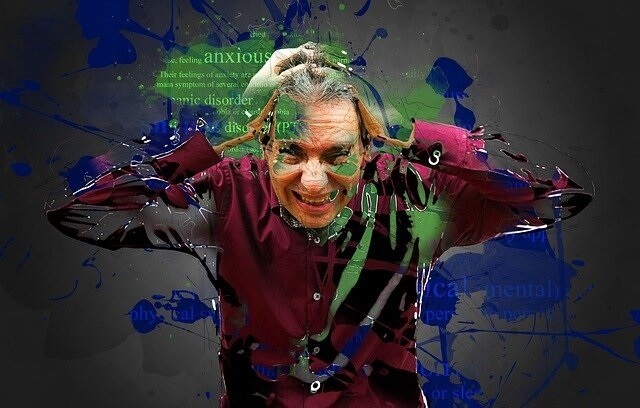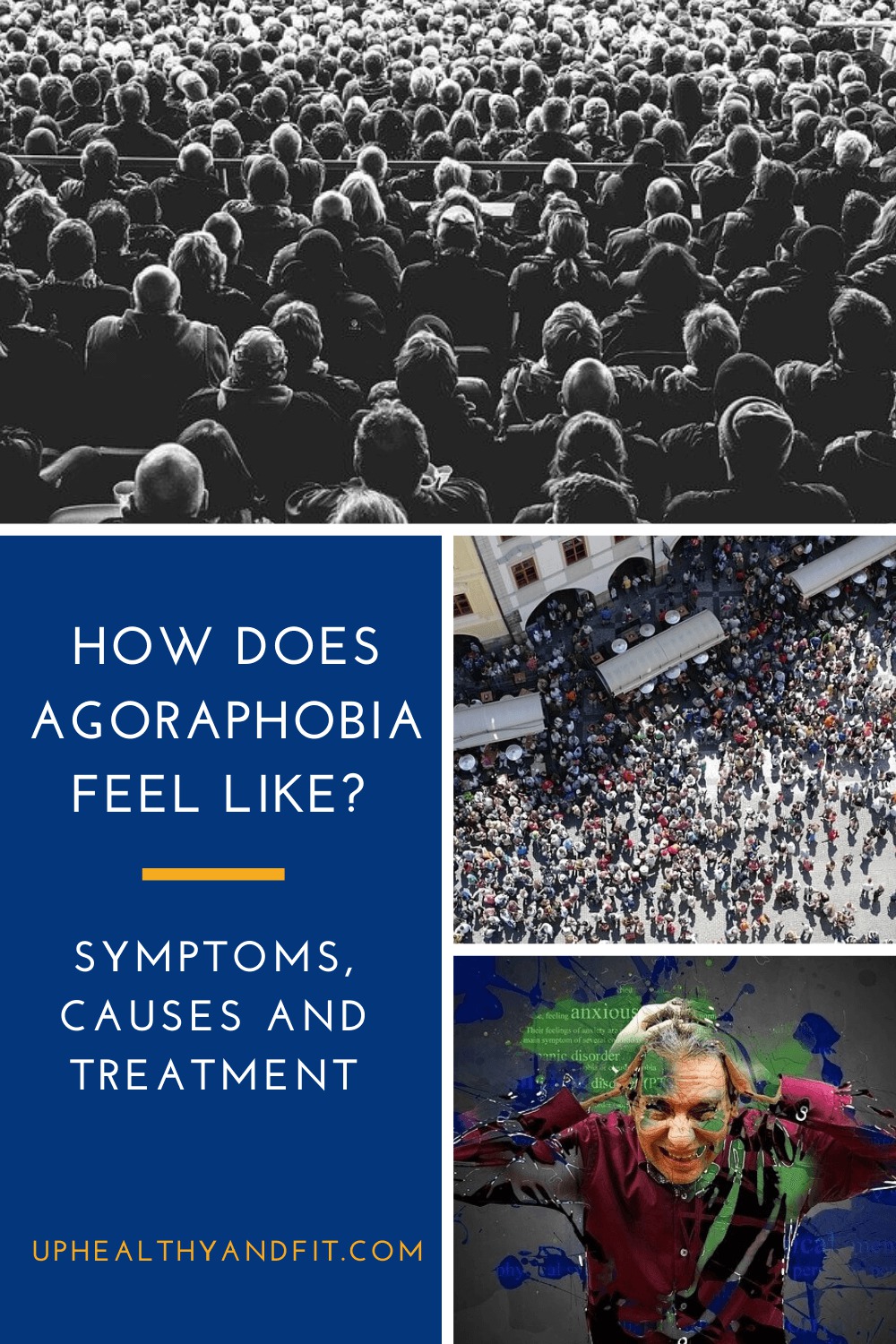Agoraphobia is an anxiety disorder characterized by symptoms of anxiety in situations where the person perceives his/her environment as unsafe and with no easy way out. These situations may include open spaces, public transportation, shopping centers, or simply being outside home. Let’s try now to understand what agoraphobia feels like, its symptoms, causes and treatment.
[adinserter name="Block 1"]From a clinical point of view, the person suffering from agarophobia gets overwhelmed by a strong anguished feeling and severe distress, when he/she is in unfamiliar situations that seem to make believe there is no way out, and help from other people is not available. In most cases, agoraphobia develops after the onset of panic attacks, minor anxiety disorders and post-traumatic stress.
The severity of agoraophobia and the attitude adopted to avoid the feared situation is subjective. In the most severe cases, besides anxiety, other physical symptoms or actual panic attacks may show up, such as sweat, high heartbeat rate, nausea and chocking.
Just like other phobias, agoraphobia may negatively impact the person’s daily life, affecting both social and work life. Luckily, this disorder may be treated also through psychotherapy, aimed at overcoming this kind of phobia.
As agoraphobia is the fear of open spaces and places, which it may be difficult or embarassing to leave,
the person suffering from this disorder:
- Has difficulty leaving house, if he/she is not accompanied;
- He/she experiences distress travelling alone on public transportation (such as bus and airplane);
- He/ she tries to avoid over-crowded locations (such as restaurants, markets, concerts, cinemas and malls).

Agoraphobia often involves symptoms like: sweat, chills or facial flushes, speedy heartbeat, nausea, choking and fear of dying.
As a consequence, the person suffering from agoraphobia tries not to have exposure to the phobic trigger and ends up adopting avoiding strategies or is in continuos search for the reassuring presence of a family member.
Agoraphobia is a disabling disorder, as the person who suffers from it:
- ends up becoming housebound;
- is forced to leave house only when accompanied.
Do you know that:
“Agoraphobia” comes from ancient Greek, “agorà”, which means “square” and “phóbos”, namely “fear” or “phobia”, so literally it means “fear of the square”.

Causes and risk factors
What are the causes of agoraphobia?
Causes are not completely known. In most cases, though, this disorder seems to stem from a traumatic experience from childhood and adolescence: if the natural instinct to explore is not promoted, a psychological block shows that affects self-perception and one’s possibilities. In adulthood, this reaction may be boosted by low self-esteem.
Symptoms and complications
[adinserter name="Block 1"]Agoraphobia: how does it feel like?
Agoraphobia is a very complex condition, which doesn’t involve just fear of open spaces or fear of the crowd. The symptoms of this disorder may be triggered by stressful situations, from which it is impossible to escape or get help in case of danger.

Thus, the person suffering from agoraphobia may fear specific situations, like:
- being in a large and open space (supermarket, parking lot or bridge);
- leaving house, if not accompanied;
- waiting in line or being among the crowd;
- taking public trasportation (for instance: train, bus, airplane);
- visiting a mall;
- attending over-crowded public locations (for instance: restaurants, markets, concerts, cinemas and malls).
What are the symptoms of agoraphobia?
Clearly, agoraphobia symptoms and severity may vary from person to person, in fact
Some people experience little anxiety and distress only when they are in unfamiliar places.
Other agoraphobic people, instead, experience a severe sense of distress and, in extreme cases, actual panic attacks.
Just like other phobic disorders, agoraphobia may trigger physiological reactions, like:
- racing heart;
- chills or flushing;
- tingling and itch;
- nausea and/or vomit;
- fainting;
- headache;
- light headedness;
- difficulty breathing;
- impaired vision;
- ringing in the ears;
- dry mouth;
- trembling;
- crying;
- numbness;
- urinary urgency;
- chest pain.
Agoraphobia: note to somatic symptoms
The physical symptoms that show up in agoraphobia, like in other forms of phobia, point out abnormal emotional response: the body is responding to the phobic trigger with an extreme expression of the physiological “fight or flight” reaction. In other words, the mind perceives open spaces as potentially dangerous, thus it gets the body ready to fight for survival. This excessive emotional response clearly shows the person suffers from a phobic disorder.
Possible implications of agoraphobia
As already mentioned, agoraphobia may limit the life of the person who suffers from it. In the most severe cases, the phobic disorder symptoms get triggered even just thinking of those situations that evoke the fear.
In most cases, agoraphobia may trigger panic attacks at the thought of:
- Not receiving assistance, in case you have an anxiety;
- Being in a place without an immediate emergency exit, available to the sight.
[adinserter name="Block 1"]Agoraphobia: associated conditions
Agoraphobia may associate with depression and obsessive behavior, as well as with social anxiety and fear of the dark and taking an airplane.
Agoraphobia may be a highly disabling disorder, as it may affect lots of daily activities and situations. This is the reason why, if the symptoms have been going on for more than six months, it is highly recommended to seek medical advice.

Agoraphobia: how to establish diagnosis?
The initial evaluation of agoraphobia is essential to understand the causes upon which the disorder is based,
thus the doctor:
- Asks the patient to describe his/her symptoms and what triggers them;
- Tries to understand how severe the symptoms are;
- Rules out other types of anxiety disorders or general pathology.
According to the Diagnostic and Statistical Manual of Mental Disorders, here’s what happens if a person suffers from agoraphobia:
- Unreasoned, persistent fear is not stirred up by a specific situation;
- In case of exposure to the stimulus, an anxiety-inducing response gets triggered: in adults, this may look like an sudden panic attack;
Adults realize their fear is unreasoned and out of proportion;
- Avoiding strategies are adopted in order not to experience the feared situation, besides having a tendency to face new experiences with a sense of anguish;
- The anxiety-inducing response, the anticipation or the avoidance of the person interfere with daily life and relations, or cause serious distress.
- What is more, in order to make a diagnosis, agoraphobia has to be ongoing for some time (6 months or even longer) and has to show symptoms that can’t be related to other emotional disorders, like Obsessive Compulsive Disorders or Post Traumatic Stress Disorder.
[adinserter name="Block 1"]Treatment and remedies
What is the agoraphobia treatment?
Agoraphobia can be faced with several therapeutic options, also combined. The most effective approaches involve relaxing techniques, meditation and cognitive-behavioral therapy, aimed at overcoming the fear of open spaces.
These strategies aim at helping the patient rationalize his/her morbid fear, trying to focus on the possibility to react to anxiety-inducing thoughts and to face the negative beliefs associated with agoraphofia.
Drugs
In combination with the psychological treatment, a psychiatrist may prescribe a drug therapy to soothe the symptoms related to the phobic disorder, like anxiety.
The types of drugs that are usually prescribed are benzodiazepines, beta-blockers, tricyclic antidepressants, selective serotonin reuptake inhibitors and monoamine oxidase inhibitors.
It is important to point out that the recourse to drug therapy may soothe the problem temporarily, but it doesn’t cure it permanently.
Exposure and desensitization therapy
An approach that has proved effective in treating agoraphobia is to expose the patient to phobic stimuli in controlled situations, in order for the patient to get desensitization.
This therapy involves gradual and repeated exposure to the situation the patient perceives as agoraphobic, in order to learn how to handle anxiety and face the negative beliefs related to the fear of open spaces, and unfamiliar places without an immediate emergency exit.
Cognitive-behavioral therapy
Desensitization can be carried out in combination with cognitive-behavioral techniques, in order to modify the agoraphobia vicious cycle and work on the meaning of the patient’s phobic stimuli.
This way, the agoraphobic patient gets exposed to the feared situations, with the chance to learn emotional self-control techniques, that allow him to resize his/her fear.
Relaxation techniques
In order to treat agoraphobia effectively, psychotherapy may be accompanied by relaxation techniques, such as autogenic traning, breathing exercises and yoga. These treatments may help cope with anxiety related to the situation the patient perceives as agoraphobic.
Another treatment that may prove helpful is hypnosis. This alternative treatment leads to such relaxation that the patient may identify the causes of his/her fears and overcome them.
Conclusion
Now that you have just finished reading this article, you know how agoraphobia feels like: it is an anxiety disorder characterized by symptoms of anxiety in situations where the person perceives his/her environment as unsafe and with no easy way out.
Agoraphobia symptoms may vary from person to person, though a few symptoms seem to affect most of the agoraphobic patients: difficulty breathing,impaired vision, dry mouth, trembling and racing heart.
When it comes to agoraphobia causes, though mostly unknown, they seem to stem from a traumatic experience from childhood and adolescence, if the natural instinct to explore is not promoted; that may cause psychological blocks that affect self-perception and one’s possibilities.
Drug therapy may be a valuable tool in agoraphobia treatment, yet it doesn’t cure agoraphobia permamently; actually, the most important aspect of the therapy of this highly disabling disorder is to help the patient to learn how to resize his/her unreasoned fear.
Cognitive-behavioral therapy and relaxation techniques have proven to be very effective if carried out by expert therapists.
If you liked my article, please share it with your friends; if you have any questions to ask me I will be more than happy to help you out, Alex

